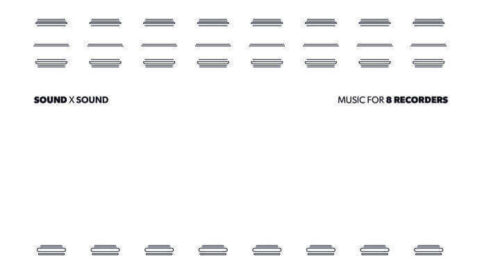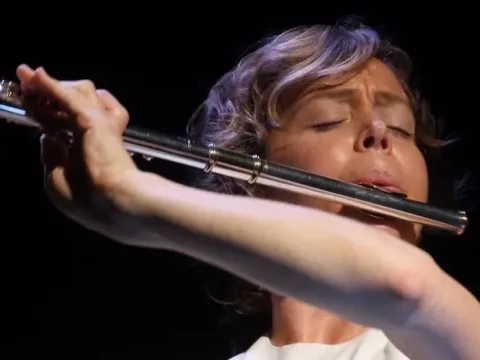Like the swirling masses of clouds that momentarily amass over Sumatran rainforests (those cumulus bodies whose outward appearance of solidity belie their effervescent transience) the floating masses of sound in Niels Lyhne Løkkegaard‘s newest record coalesce into an audibly ephemeral cluster that swells and dissipates in much the same manner, except as if under time-lapse. The listener, already familiar with these barely visible transformations of form that play out across the bodies of clouds, will find that Music for 8 Recorders disappears as much as it appears and reappears within these temporal parameters. In its on-going re-shaping and re-forming of itself, the like-ness of each instrument’s sonic similitude is the limitation by which musical ideas are dispassionately explored in the promising new series SOUND X SOUND, of which Music for 8 Recorders is the first installment.
Shipping as a 7” vinyl record, the album is comprised of two sections, each section adhering exclusively to one of two different families of recorder: Alto and Soprano. Danish composer Niels Lyhne Løkkegaard, a reed instrumentalist and alumni of the Rytmisk Musikkonservatorium in Copenhagen, brings vital organic pulsation and movement into to these two contrasting sections, as well as a thermodynamic responsivity. By exploiting the registers and sonority of the different recorders to a completely different effect, he arranges each side of the record as a negation of what came before. He creates this differentiation both within the overarching structure as well as through the development of different levels of rhythmical intensity: for instance the alto recorder section contains different periods of growth and depth, as could be depicted with an aplitudhedron, whereas the soprano recorder section is more like the substrate of a dense particle field, always buzzing … swirling … changing position … everywhere and nowhere all at once.

The simplicity often linked to recorder music, by way of its uniform timbral quality as well as its association with schools and with children (in maybe their first contact with an instrument), is but the first layer of associations Løkkegaard seems eager to embrace as well as dispel. The mechanism by which these instruments are stacked and their sound compacted together makes one forget that we are, in fact, listening to recorders … that is unless we actively pluck out individual lines from the additive mass. This, however, would detract from the overall experience of the mass itself, which Løkkegaard is pointing us towards, with its drone-like hypnotic affectation and its ecosystems of dynamic beating. A second layer of associations arise from historical memory, as if the compressed frenzy of calls and oscillations is being issued from another time; are we hearing the battle cries of Eric Bloodaxe? Or perhaps we are listening to dream fragments belonging to Harald Bluetooth, who long ago walked Denmark in an age when music was imagined with the sounds of a similarly primordial essence? Yet a third layer which cannot be discounted (which is evoked mightily by the shrill purity of the resonance in Løkkegaard’s music here) is the associations linking Music for 8 Recorders to the natural world, to a world before time and before history. This is a zone where birds rule the skies and reptiles submerge into the depths. The uncanny cacophony of the soprano recorder section, in particular, recalls those tiny subantarctic islands, relics of deep time, where birds congregate in astronomical numbers to mate and to nest. The coextensive homogeneity of the timbre reinforces complex associations and (re)awakens these ancient memories.
Just as clouds undergo changing processes brought upon by external environmental pressures, we can imagine each breath of each player, each pulsation in Music for 8 Recorders as the composite of one of many of these external pressures. We can also imagine the sound they produce together as mirroring the mutations and dynamic flows that play out across nature. In a short video teaser for this recording that Løkkegaard has posted to his YouTube channel, we get a glimpse of the eight players merging into one, their lines blending together in a replay of evolutionary processes. The SOUND X SOUND Series aims to chart more of this type of homogeneity-as-resource, in which it will quest for more musical potential within the realm of the singular. Løkkegaard, whose works have earned him numerous Danish and European music prizes, has created a beautiful new record worthy of repeated listening, one subject to the listener’s preference for playback speed (33 1⁄3 rpm, anyone?) as well as the listener’s innate connection to time immemorial.









